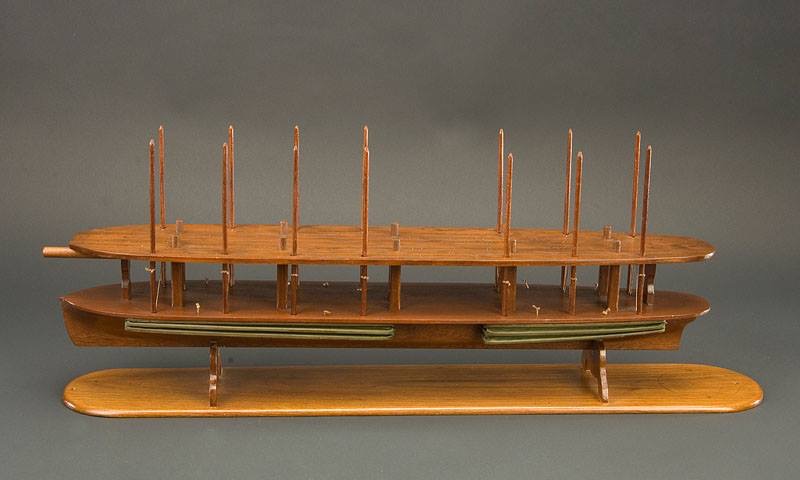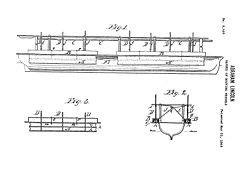Abraham Lincoln is the only president ever to get a patent, for “an improved method of getting vessels over shoals.” He submitted his patent application on March 10, 1849. It was approved two months later. The story leading up to the patent had begun years ago.
Soon after moving to Illinois at the age of 21, Lincoln took his second flatboat trip to New Orleans. Early in the trip his flatboat found itself stuck on the New Salem mill dam. A heroic and ingenious escape involving a bored hole in the bow of the boat put him back on his way. He was so enamored with the people of New Salem that he moved there upon his return.

Years later the lawyer Lincoln tried several patent cases. He also served a term in the U.S. Congress. After his first session in Congress he toured New England campaigning for Zachary Taylor as the Whig nominee for president. Lincoln then took a roundabout route past Niagara Falls and through the Great Lakes by steamship, and along the newly opened Illinois and Michigan Canal on his way back to Springfield. While passing through the Detroit River he witnessed another steamboat stuck on a shoal. The captain ordered crew to jam logs, boards, barrels, and anything else floatable under the hull of the ship. It worked, and the ship was able to free itself from the obstruction.
Always observant, Lincoln noted this effort and upon arriving back to his legal practice in Springfield started sketching out a method for rectifying the problem. Lincoln’s invention “combine[d] adjustable buoyant air chambers with a steam boat for the purpose of enabling their draught of water to be readily lessened to enable them to pass over bars, or through shallow water, without discharging their cargoes.” With the help of a local woodworker he constructed a wooden model. He also hired a patent lawyer in Washington to help him prepare the application.

He received Patent No. 6469. The system was never put to practical use, but it demonstrated Lincoln’s analytical mind and interest in technology, skills that often came into place in his court cases.
David J. Kent is an avid science traveler and the author of Lincoln: The Man Who Saved America, in Barnes and Noble stores now. His previous books include Tesla: The Wizard of Electricity and Edison: The Inventor of the Modern World and two e-books: Nikola Tesla: Renewable Energy Ahead of Its Time and Abraham Lincoln and Nikola Tesla: Connected by Fate.
Check out my Goodreads author page. While you’re at it, “Like” my Facebook author page for more updates!











Patent number US6469A! Did a quick patent search… Apparently the research for the original patent only noted one “similar” patent, number 2004 (improved steamship propulsion). Nowadays, I think the USPTO issues something like 150,000 in a single year, and they have to be cross-researched internationally. The research alone is horrific, and yet someone was able to patent the idea of using a laser-pointer to entertain a cat.
I’ve never been entirely clear on the pre-USPTO history of US patents or exactly who or what department was responsible for them. I guess about 10,000 from the early US were lost to fire; so was Lincoln’s issued with a new numbering system? And I know the Confederacy issued patents. (I recall that one was for the Merrimac.) What happened to those?
I have a book dated 1850 that lists all the patents from the previous year with a short one paragraph summary of each. It simply states Patent #6469. Seems to have been about 19,000 patents during the Civil War in the North (the South couldn’t patent in the US system during the war).
I did a quick search to find out about Confederate patents and apparently they did have a patent office. There seems to have been only 274 confederate patents during the entire span of the war. I’m not sure if that counts the deferred ones (they could defer the patent until after the war so they didn’t 1) lose patent protection time, or 2) have the idea stolen by the North). This book seems like a good one on the topic and I might just pick it up: https://digitalcommons.lsu.edu/cgi/viewcontent.cgi?article=2110&context=cwbr
I just did a quick lookup at the USPTO. I was wondering about the numbering and how many US patents had actually been filed by that point.
Interesting book… just ordered a copy myself. This is a good reminder of how civilizations reflect social agreements about the value of human works (something Lincoln well understood!). You may recall that I’ve written about “intellectual property” here. Having been through the process in four countries, all signatories to the “Patent Cooperation Treaty”, curious about the original implementation in the US.
How many patents do you have?
Complicated answer depending upon the definition of “have”… but effectively none at present. I’ve always treated them as a means to an end.